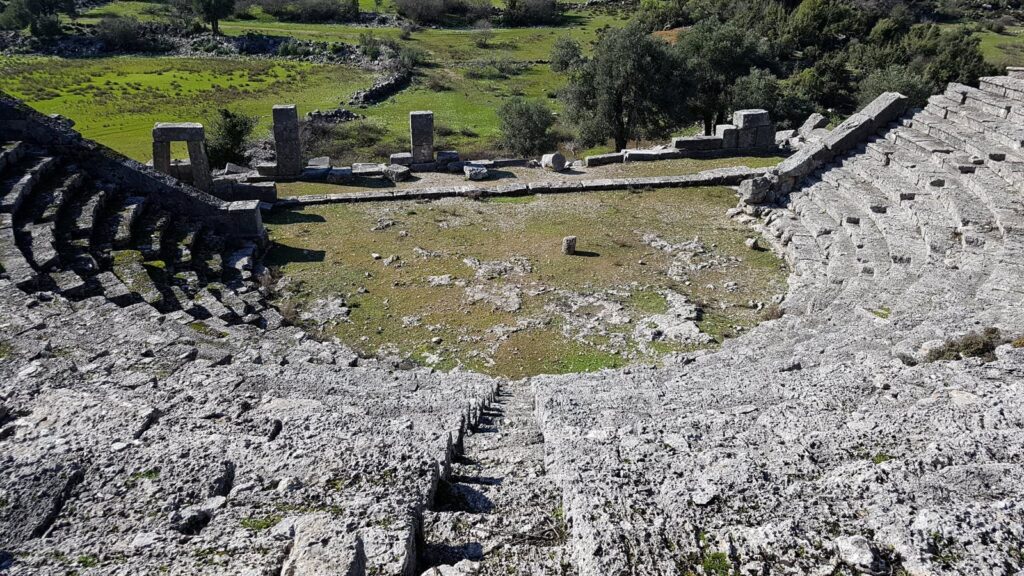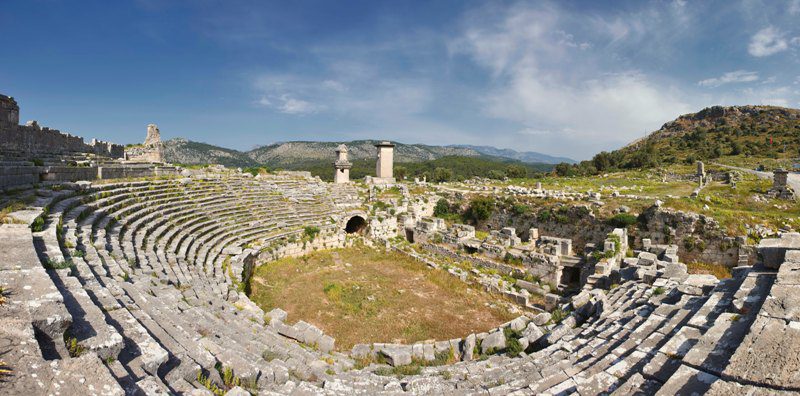Fethiye Travel Guide
Introduction
Fethiye Travel Guide – With glorious lagoons, hidden caves and pine-clad mountains, a holiday in Fethiye promises enough heavenly scenery to last a lifetime. Located on the southwest coast of Turkey within the Muğla Province, the district is a sublime mix of old and new. Sleek, Mediterranean style villas rub shoulders with ancient historical sites while dramatic mountain ranges overlook glorious beaches of the Lycian Coast. Pleasing everyone from history buffs to island hoppers, all sorts of adventures await in Fethiye. Google Fethiye, Turkey, and you’ll have plenty of search results telling you what the ‘Best things to do in Fethiye’ are. The truth is, there are so many things one can do here that they won’t fit into a single blog post.
Fethiye is the perfect launching pad to explore the many tourist attractions and things to do along Turkey’s Turquoise Coast. This harborside town is in a prime position for heading out to the surrounding beaches or going inland to discover the crumbling remnants of this region’s ancient Lycian culture. If it’s all about location, Fethiye provides it all. The town itself is a prosperous but laid-back kind of place; just what you need to return to after a day’s hectic sightseeing of mighty rock-cut tombs and mountain-top, UNESCO-protected ruins or sunbathing bliss, boating, and paragliding action.

Stunning Fethiye is located in the heart of the Turkish Riviera. This ancient city, once named Telmessos, was the most important city of Lycia, with a history on record starting in the 5th century BC. The location of Fethiye is just one of the reasons it was voted number one for best tourism centre in the world by The Times and The Guardian in 2007. One of the other reasons is because it’s one of the best spots to begin a blue cruise on a traditional Turkish gulet.

Explore the vibrant market place or visit the Tomb of Aminthas cut high in the rocks of Fethiye, or continue on to Kayakoy “the ghost town”, where the entire village is a standing museum containing many ancient Greek-style houses and churches that cover a mountainside. Historic ruins such as the Hellenistic theatre are located in the city centre and are currently being renovated in the hope of holding grand open-air concerts and operas under the stars. Fethiye is a true treasure of the Mediterranean coast. It’s located close to tourist hotspots such as the thermal springs of Pamukkale and the ancient wonders of Ephesus, but most importantly it’s the ultimate jump-off point for sailing around the Mediterranean. From here you can begin to sail around Turkey in luxury exploring all the natural aquatic wonders this beautiful country has to offer. A trip to Olympos, Rhodes, and the Blue Cave are only a few of the magical places that are just a short sail away.
How to get there
Airlines such as easyjet, Jet2, Pegasus Airlines, British Airways, Turkish Airlines etc fly directly to Dalaman International Airport (DLM), which is less than an hour’s drive to Fethiye, via the Göcek Tunnel. There are no rail links from the airport, so arrange car hire or private transfer, or pick up an airport taxi on arrival. You can get around Fethiye via taxi or via the main bus (Dolmus) which connects many key resorts.
The Rich History of Fethiye
When traveling, never cease to be amazed. It is a beautiful quote that will be easy to live by here. Turkey has a rich historical heritage, and Fethiye is no exception to that. Here, ancient remains are part of daily life. The town emerged on Lycian soil, and one of its famous landmarks, the tomb of Amynthas is still overlooking the bay. The tomb dates back to the 4th century BC and from its location, you’ll have a stunning view of the city below. How often will you encounter a Lycian sarcophagus as a roundabout? Probably not that often. But you will in Fethiye, and just like it did with us, it will put a smile on your face. As will discovering people putting up their laundry on the fence of a Lycian graveyard. And since not all historical artifacts can be left where they were found, Fethiye Müze has become home to some amazing pieces that have been recovered from the many ancient sites in the area. In the museum, you will find statues, ceramics, coins, jewelry, and other archaeological finds from the sites of Letoon, Xanthos, and Tlos among others.
Best Attractions in and around Fethiye
Lycian Sites
The Lycians ruled over this stretch of Turkey’s coast from 200 BC, and Fethiye stands on the site of the important Lycian city of Telmessos. There are plenty of monuments scattered throughout the city, but the most famous is the rock-cut Tomb of Amyntas in the south of Fethiye. On Kaya Caddesi, as you walk up the hill towards the tomb, you can see Lycian sarcophagi along the way. More Lycian sarcophagi are also by the town hall in the city center.
Telmessos Theater

When the Romans conquered Turkey, they allowed the independently minded Lycians self-rule, but that didn’t stop them making their own mark on the Lycian cities. Fethiye’s small and only partially excavated theater was built in the 2nd century BC, when Telmessos had become part of Rome‘s Asia Minor dominion. It would have originally seated 6,000 spectators. Climb up to the top tier of seating for great views across town and over the sea beyond. The park opposite the theater is a good place to relax and seek some shade on a summer’s day.
Fethiye Museum

It may be small, but Fethiye Museum is an excellent place to get a grip on Lycian history, especially if you’re planning to head on to attractions such as Tlos and Letoön. Brilliant information panels clearly explain Lycian culture, and the exhibits of pottery, jewelry, and stele are beautifully displayed. The museum’s pride and joy is the Trilingual Stele (inscribed with Lycian, ancient Greek, and Aramaic) found while excavating Letoön. This stone helped archaeologists to finally crack the Lycian language.
Ölüdeniz Lagoon

Turkey’s most famous beach is 15 kilometers from Fethiye. The calm turquoise water, sheltered from the sea, with its white-sand beach rimmed by dense pine forest, is impossibly perfect, which is why people have been flocking here for years now. Some of Ölüdeniz’s sheen has been shaken off over the past two decades, as package tourism arrived on the scene, but the lagoon area has not seen the construction development of other tourism hot spots, and the village attached to the lagoon is still a low-story unobtrusive affair. If you don’t want to swim or sunbathe then the other big activity here is paragliding. Mt. Baba (Baba Dag) dominates the scenery inland, and paragliders launch themselves off the peak throughout the summer months. Even beginners can have a go with a tandem paragliding flight.
Kayaköy
This is not an ancient site with a theater, Greek or Roman pillars, or anything of the kind. This is an ordinary village, except it has been abandoned, and it became a ghost village. After it was deserted, it got hit by an earthquake. Fortunately, there is still enough standing to make it an attractive place to visit. Both Greek churches are currently closed for restoration. Luckily, a hole in the wall surrounding the upper church area makes it easy to have a peek anyhow. Up until the 1920s, Kayaköy (ancient Karmylassos), eight kilometers from Fethiye, had a thriving mixed population of Greeks and Turks who had lived together for centuries. The 1923 Population Exchange changed all of that, uprooting ethnic Greeks across Turkey and sending them to live in Greece and making ethnic Turks who lived in Greece abandon their lives there. The exchange created heartbreak and much trauma among those who were made to leave, and the somber results of this are no better seen than in Kayaköy. The dilapidated, eerie stone village that snakes across the hillside here has been left to slowly decay since its Greek owners said goodbye. Among the ruins is the Katapongagia Church and Taxiarchis Church, which both still have some beautiful interior decoration

Saklikent Gorge
This ravine, 30 kilometers from Fethiye, is cut deeply into the mountains of the Akdaglar Range. Most visitors come to trek the gorge, which has wooden boardwalks along part of the trail high above the river. The last section of the trail is reached by fording the swift-running river itself and then walking through the narrow fissure to the end. Cushion-strewn tea houses are beside the river here if you don’t fancy walking through the freezing cold water. There are also canyoning and rafting trips along the river for the more actively inclined visitor.

Pınara

In the hills southeast of Fethiye, the ruins of the Lycian city of Pinara are chiefly interesting for their honeycombed cliff of more than 900 rock tombs and monolithic house tombs. The site was so inaccessible that the tomb-builders had to be lowered on stages secured with ropes. The beautiful scenery that surrounds the ruins is lushly stunning, especially around the theater area overlooked by snow-topped peaks and rimmed by verdant forest. This is one of the quieter Lycian sites in the area and rarely gets busy with tourists
Letoon

This UNESCO-protected ruin was an important Lycian religious center dedicated to the Greek goddess Leto who, according to local mythology, was banished to Lycia by Zeus’ jealous wife Hera after an affair with the great Greek god. The three temples here are dedicated to Leto and her twin children by Zeus, Apollo and Artemis. The site is incredibly atmospheric and a wonderful accompaniment to a visit to Xanthos, the ancient capital of Lycia. In particular, check out the well-preserved mosaic in the floor of the Apollo temple
Xantos

Xanthos was the capital of ancient Lycia, sometimes called “the oldest republic in the world.” This league of 20 cities was governed by a popular assembly and a president who ruled from Xanthos. The site is now protected by UNESCO. Although many of Xanthos’ most beautiful monuments were taken to England in the 19th century, some fine mosaics are still in situ, and the theater, agora, and acropolis can still be seen. Beyond the Roman theater, to the left of the road, is the plinth that once held the Nereid Monument, an ionic temple with rich sculptural decoration (now displayed in the British Museum). To the right of the road is the Hellenistic city gate. The city walls, considerable stretches of which are still visible, probably date from the 3rd century BC.
Butterfly Valley
This lovely beach, secreted between two sharp cliffs, is home to the Jersey Tiger Butterfly. One of the joys of Butterfly Valley is that it is unreachable by road. You either have to trek here from Faralya village, high above on the cliff, or take a boat (during summer they leave a couple of times daily) from Ölüdeniz. Great hiking opportunities are in the lush forested gorge behind the beach, though most people are happy to just stretch out on the sand.
Tlos

High up in the hills that surround Fethiye, Tlos is another Lycian city ruin. Crowning the rounded acropolis hill are the remnants of an Ottoman fortress. The Lycians weren’t the only ones to appreciate a good mountain stronghold position, and this fortress was used by various local brigands during Ottoman rule. On the east side of the acropolis, the remains of the Lycian and Roman city walls can still be seen. Beyond lie the scattered ruins of houses and public buildings, including a hall-like edifice (possibly an indoor market), an agora, necropolis, and a restored theater
Patara

Patara is home to Turkey’s longest beach, so it’s the perfect spot for a sun and sand break. This was also once an important city in the Lycian League, and plenty of ruins are just off the beach area when you’ve had enough of the sea. The ruins of ancient Patara are entered through a Roman era triple-arched gate near a well-preserved theater, colonnaded street, a bath complex, and plenty of tombs. The city was used right up to the Byzantine period, and a basilica can also be seen. Patara’s other claim to fame is it’s also the birthplace of St. Nicholas of Myra (modern Demre, near Kas), the 4th-century bishop, who became “Santa Claus.”
St Nicholas Island (Gemiler Island)
Indeed, Saint Nicholas Island is a name used by foreigners; locals use its Turkish name: Gemiler Adası. The name Saint Nicholas island didn’t come falling from the sky. It has everything to do with the island’s history, which is said to have been used as a refuge by Saint Nicholas and his followers to escape the Roman persecution in the 4th Century. They founded and built a monastic retreat on the island, including several churches and plenty of other buildings and corridors. It is widely accepted that the island was also the original burial place of Saint Nicholas. But his bones were removed and taken to Myra after people abandoned the island in the 7th century due to the Arab fleet’s threats. The Turkish Ministry of Culture and Tourism manages Saint Nicholas Island. Still, apart from a few signs and warnings to stay on the (naturally created) paths, you will pretty much feel like an explorer discovering its mystery. In fact, during our out of season visit, we were the only people there. The only company we had was a ginger cat and some goats.










